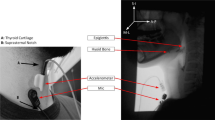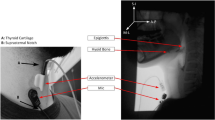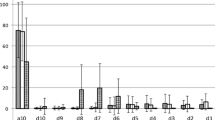Abstract
Few research studies have investigated temporal kinematic swallow events in healthy adults to establish normative reference values. Determining cutoffs for normal and disordered swallowing is vital for differentially diagnosing presbyphagia, variants of normal swallowing, and dysphagia; and for ensuring that different swallowing research laboratories produce consistent results in common measurements from different samples within the same population. High-resolution cervical auscultation (HRCA), a sensor-based dysphagia screening method, has accurately annotated temporal kinematic swallow events in patients with dysphagia, but hasn’t been used to annotate temporal kinematic swallow events in healthy adults to establish dysphagia screening cutoffs. This study aimed to determine: (1) Reference values for temporal kinematic swallow events, (2) Whether HRCA can annotate temporal kinematic swallow events in healthy adults. We hypothesized (1) Our reference values would align with a prior study; (2) HRCA would detect temporal kinematic swallow events as accurately as human judges. Trained judges completed temporal kinematic measurements on 659 swallows (N = 70 adults). Swallow reaction time and LVC duration weren’t different (p > 0.05) from a previously published historical cohort (114 swallows, N = 38 adults), while other temporal kinematic measurements were different (p < 0.05), suggesting a need for further standardization to feasibly pool data analyses across laboratories. HRCA signal features were used as input to machine learning algorithms and annotated UES opening (69.96% accuracy), UES closure (64.52% accuracy), LVC (52.56% accuracy), and LV re-opening (69.97% accuracy); providing preliminary evidence that HRCA can noninvasively and accurately annotate temporal kinematic measurements in healthy adults to determine dysphagia screening cutoffs.







Similar content being viewed by others
References
Humbert IA, Robbins J. Dysphagia in the elderly. Phys Med Rehabil Clin N Am. 2008;19(4):853–66. https://doi.org/10.1016/j.pmr.2008.06.002.
Namasivayam-MacDonald AM, Riquelme LF. Presbyphagia to dysphagia: multiple perspectives and strategies for quality care of older adults. Semin Speech Lang. 2019;40:227–42. https://doi.org/10.1055/s-0039-1688837.
Lof GL, Robbins J. Test-retest variability in normal swallowing. Dysphagia. 1990;4:236–42. https://doi.org/10.1007/BF02407271.
Robbins J, Hamilton JW, Lof GL, Kempster GB. Oropharyngeal swallowing in normal adults of different ages. Gastroenterology. 1992;103:823–9.
Mancopes R, Gandhi P, Smaoui S, Steele CM. Which physiological swallowing parameters change with healthy aging? OBM Geriat. 2021. https://doi.org/10.21926/obm.geriatr.2101153.
Jardine M, Miles A, Allen J. A systematic review of physiological changes in swallowing in the oldest old. Dysphagia. 2020;35:509–32. https://doi.org/10.1007/s00455-019-10056-3.
Humbert IA, Sunday KL, Karagiorgos E, Vose AK, Gould F, Greene L, et al. Swallowing kinematic differences across frozen, mixed, and ultrathin liquid boluses in healthy adults: age, sex, and normal variability. J Speech Lang Hear Res. 2018;61:1544–59. https://doi.org/10.1044/2018_JSLHR-S-17-0417.
Martin-Harris B, Brodsky MB, Michel Y, Castell DO, Schleicher M, Sandidge J, et al. MBS measurement tool for swallow impairment–MBSImp: establishing a standard. Dysphagia. 2008;23:392–405. https://doi.org/10.1007/s00455-008-9185-9.
Mulheren RW, Azola AM, Kwiatkowski S, Karagiorgos E, Humbert I, Palmer JB, et al. Swallowing changes in community-dwelling older adults. Dysphagia. 2018;33:848–56. https://doi.org/10.1007/s00455-018-9911-x.
Robbins J, Coyle J, Rosenbek J, Roecker E, Wood J. Differentiation of normal and abnormal airway protection during swallowing using the penetration-aspiration scale. Dysphagia. 1999;14:228–32. https://doi.org/10.1007/PL00009610.
Garand KLF, Hill EG, Amella E, Armeson K, Brown A, Martin-Harris B. Bolus airway invasion observed during videofluoroscopy in healthy, non-dysphagic community-dwelling adults. Ann Otol Rhinol Laryngol. 2019;128:426–32. https://doi.org/10.1177/0003489419826141.
Steele CM, Peladeau-Pigeon M, Barbon CAE, Guida BT, Namasivayam-MacDonald AM, Nascimento WV, et al. Reference values for healthy swallowing across the range from thin to extremely thick liquids. J Speech Lang Hear Res. 2019;62:1338–63. https://doi.org/10.1044/2019_JSLHR-S-18-0448.
Vose AK, Kesneck S, Sunday K, Plowman EK, Humbert I. A survey of clinician decision making when identifying swallowing impairments and determining treatment. J Speech Lang Hear Res. 2018;61:2735–56. https://doi.org/10.1044/2018_JSLHR-S-17-0212.
Beall J, Hill EG, Armeson K, Garand KLF, Davidson KH, Martin-Harris B. Classification of physiologic swallowing impairment severity: a latent class analysis of modified barium swallow impairment profile scores. Am J Speech Lang Pathol. 2020;29:1001–11. https://doi.org/10.1044/2020_AJSLP-19-00080.
Dudik JM, Coyle JL, Sejdić E. Dysphagia screening: contributions of cervical auscultation signals and modern signal-processing techniques. IEEE Trans Hum Mach Syst. 2015;45:465–77. https://doi.org/10.1109/THMS.2015.2408615.
Sejdić E, Steele CM, Chau T. Classification of penetration–aspiration versus healthy swallows using dual-axis swallowing accelerometry signals in dysphagic subjects. IEEE Trans Biomed Eng. 2013;60:1859–66. https://doi.org/10.1109/TBME.2013.2243730.
Dudik JM, Jestrovic I, Luan B, Coyle JL, Sejdic E. A comparative analysis of swallowing accelerometry and sounds during saliva swallows. Biomed Eng Online. 2015;14(1):3.
Dudik JM, Kurosu A, Coyle JL, Sejdić E. A comparative analysis of DBSCAN, K-means, and quadratic variation algorithms for automatic identification of swallows from swallowing accelerometry signals. Comput Biol Med. 2015;59:10–8. https://doi.org/10.1016/j.compbiomed.2015.01.007.
Jestrović I, Dudik JM, Luan B, Coyle JL, Sejdić E. Baseline characteristics of cervical auscultation signals during various head maneuvers. Comput Biol Med. 2013;43:2014–20. https://doi.org/10.1016/j.compbiomed.2013.10.005.
Dudik JM, Coyle JL, El-Jaroudi A, Mao Z-H, Sun M, Sejdić E. Deep learning for classification of normal swallows in adults. Neurocomputing. 2018;285:1–9. https://doi.org/10.1016/j.neucom.2017.12.059.
Yu C, Khalifa Y, Sejdic E. Silent aspiration detection in high resolution cervical auscultations. IEEE EMBS Int Conf Biomed Health Inform (BHI). 2019;1–4.
Mao S, Zhang Z, Khalifa Y, Donohue C, Coyle JL, Sejdic E. Neck sensor-supported hyoid bone movement tracking during swallowing. R Soc Open Sci. 2019;6:181982. https://doi.org/10.1098/rsos.181982.
Donohue C, Mao S, Sejdić E, Coyle JL. Tracking hyoid bone displacement during swallowing without videofluoroscopy using machine learning of vibratory signals. Dysphagia. 2020. https://doi.org/10.1007/s00455-020-10124-z.
Mao S, Sabry A, Khalifa Y, Coyle JL, Sejdic E. Estimation of laryngeal closure duration during swallowing without invasive X-rays. Future Gener Comput Syst. 2021;115:610–8. https://doi.org/10.1016/j.future.2020.09.040.
Khalifa Y, Donohue C, Coyle JL, Sejdic E. Upper esophageal sphincter opening segmentation with convolutional recurrent neural networks in high resolution cervical auscultation. IEEE J Biomed Health Inform. 2020. https://doi.org/10.1109/JBHI.2020.3000057.
Donohue C, Khalifa Y, Perera S, Sejdić E, Coyle JL. How closely do machine ratings of duration of UES opening during videofluoroscopy approximate clinician ratings using temporal kinematic analyses and the mbsimp? Dysphagia. 2020. https://doi.org/10.1007/s00455-020-10191-2.
Khalifa Y, Donohue C, Coyle J, Sejdic E. On the robustness of high-resolution cervical auscultation-based detection of upper esophageal sphincter opening duration in diverse populations. Proc. SPIE 11730, Big Data III: Learning, Analytics, and Applications. 2021;117300M.
Kurosu A, Coyle JL, Dudik JM, Sejdic E. Detection of swallow kinematic events from acoustic high-resolution cervical auscultation signals in patients with stroke. Arch Phys Med Rehabil. 2019;100:501–8. https://doi.org/10.1016/j.apmr.2018.05.038.
Donohue C, Khalifa Y, Perera S, Sejdić E, Coyle JL. A preliminary investigation of whether HRCA signals can differentiate between swallows from healthy people and swallows from people with neurodegenerative diseases. Dysphagia. 2020. https://doi.org/10.1007/s00455-020-10177-0.
Oppenheim AV, Schafer RW, Buck JR. Discrete-Time Signal Processing. 2nd ed. Upper Saddle River, New Jersey: Prentice Hall Inc; 1999.
Takahashi K, Groher ME, Michi K. Methodology for detecting swallowing sounds. Dysphagia. 1994;9:54–62. https://doi.org/10.1007/BF00262760.
Shrout PE, Fleiss JL. Intraclass correlations: Uses in assessing rater reliability. Psychol Bull. 2005;86(2):420–28.
Dudik JM, Jestrović I, Luan B, Coyle JL, Sejdić E. A comparative analysis of swallowing accelerometry and sounds during saliva swallows. Biomed Eng Online. 2015;14:3. https://doi.org/10.1186/1475-925X-14-3.
Sabry A, Mahoney AS, Mao S, Khalifa Y, Sejdić E, Coyle JL. Automatic estimation of laryngeal vestibule closure duration using high-resolution cervical auscultation signals. Perspect ASHA Spec. 2020;5:1647–56. https://doi.org/10.1044/2020_PERSP-20-00073 (Interest Groups).
Acknowledgements
People: Thanks are due to Tara Smyth, M.A., Dan Kachnycz, B.A., and Erin Lucatorto, M.A. for assistance with data collection and coding.
Funding
Research reported in this publication was supported by the Eunice Kennedy Shriver National Institute of Child Health & Human Development of the National Institutes of Health under Award Number R01HD092239, while the data was collected under Award Number R01HD074819. The content is solely the responsibility of the authors and does not necessarily represent the official views of the National Institutes of Health.
Author information
Authors and Affiliations
Corresponding author
Ethics declarations
Conflict of interest
We have no conflicts of interest to declare.
Ethical Approval
All procedures performed in studies involving human participants were in accordance with the ethical standards of the institutional and/or national research committee and with the 1964 Helsinki declaration and its later amendments or comparable ethical standards.
Informed Consent
Informed consent was obtained from all individual participants included in the study.
Additional information
Publisher's Note
Springer Nature remains neutral with regard to jurisdictional claims in published maps and institutional affiliations.
Rights and permissions
About this article
Cite this article
Donohue, C., Khalifa, Y., Mao, S. et al. Establishing Reference Values for Temporal Kinematic Swallow Events Across the Lifespan in Healthy Community Dwelling Adults Using High-Resolution Cervical Auscultation. Dysphagia 37, 664–675 (2022). https://doi.org/10.1007/s00455-021-10317-0
Received:
Accepted:
Published:
Issue Date:
DOI: https://doi.org/10.1007/s00455-021-10317-0




